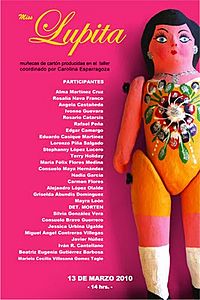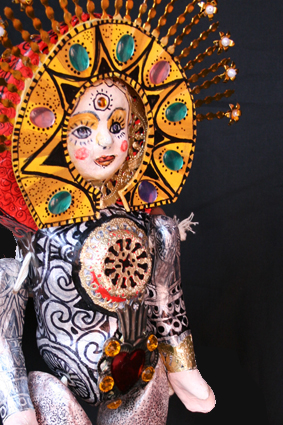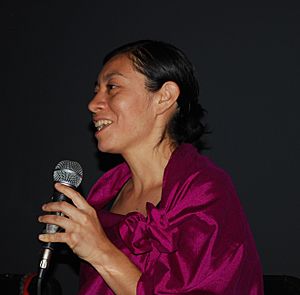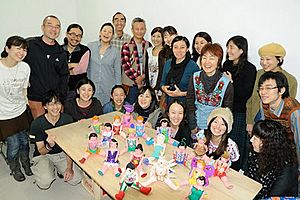Miss Lupita project facts for kids
Quick facts for kids
Miss Lupita project
|
|
|---|---|

Poster from the project
|
|
| Nationality | Mexican |
| Movement | Mexican handcrafts and folk art |
The Miss Lupita project started in Mexico City. Its main goal is to bring back the old art of making Lupita dolls. These special dolls first appeared a long time ago, in the late 1700s and early 1800s. They were a way for families who didn't have much money to have dolls, like the fancy ones imported from other countries.
Lupita dolls are made from a very strong kind of papier-mâché called "cartonería". This same material is used to create famous alebrijes and cool skeleton figures for Day of the Dead. Over time, fewer people made Lupita dolls. Now, only a few workshops in Celaya, Guanajuato, still make and sell them, mostly for collectors. The Miss Lupita project wanted to make new, modern designs. They offered free workshops to teach people how to make these dolls. The amazing dolls made in these workshops have been shown in Mexico City, Japan, and Portugal. They have also been featured in many Mexican magazines.
Contents
What are Lupita Dolls?
The Miss Lupita project is named after "Lupita" dolls. "Lupita" is a cute nickname for Guadalupe. These dolls are made from hard papier-mâché. They first appeared when Mexico was still a colony of Spain, and later during the early years of Mexico's Independence. Poorer families created them to look like the expensive dolls brought in from Spain.
The special papier-mâché method used is called cartonería. It makes the doll's surface very hard when it dries. The doll's body and head are made separately from its arms and legs. These parts are then connected with strings, so the doll's limbs can move. This cartonería technique is still used today for many crafts. You can see it in the bright and colorful alebrijes. It's also used to make the fun skeleton figures and other decorations for Day of the Dead.
However, Lupita dolls are not as popular as they once were. Today, you can mostly find them in workshops in Celaya, Guanajuato. They are often bought by people who collect unique art pieces.
Workshops in Mexico City
The Miss Lupita project began in Mexico City in 2010. Its main goal was to bring the art of making these dolls back to life. The project got its name from how these dolls are called in Mexico City. (In Celaya, they are just called cartonería dolls). The project aimed to create new and modern doll designs. These designs were inspired by city culture. They taught people how to make them through workshops in Mexico City.
Carolina Esparragoza started the project in January 2010. She still leads it today. Carolina was born in Mexico City in 1977. She studied art at a famous school called the Escuela Nacional de Pintura, Escultura y Grabado "La Esmeralda". Besides Miss Lupita, she has worked on video and art projects with other groups. She has shown her artwork in both Mexico and the United States.
The project first received support from the Fondo Nacional para la Cultura y las Artes (FONCA). Other artists and writers also helped the project. These included Maria Eugenia Chellet, Carlos Derramadero, and Ana Clavel. Six free workshops were held in different parts of Mexico City in 2010 and 2011. The only rule was that participants had to attend all six sessions. The workshops taught about the history of the dolls and how to make them.
More than 100 people joined the workshops. They were men and women, from 12 to 71 years old. The group included artists, students, homemakers, and other professionals. One person even traveled all the way from Maravatío, Michoacán, just to attend!
The workshops resulted in 134 unique dolls. Each doll was about 45 cm tall. On average, it took about 25 hours to complete one doll. The designs were very creative. Some dolls looked like dancers, while others were lucha libre wrestlers. There were also mermaids, Godzilla figures, goddesses, and cats. One doll was even made to look like famous women from Mexico. The dolls were given fun names like Siempre Viva, Hanami, and Lupe la Brava. One doll, named Andy, was a tribute to the famous artist Andy Warhol.
The finished dolls were first shown in different cultural centers in Mexico City. These included the Casa Talavera Cultural Center. An exhibition of 20 dolls was held in September 2011. It was at the headquarters of the Mexico City Human Rights Commission. The José María Velasco Gallery also featured the project. They displayed five of the dolls as their "Piece of the Month." "Beauty contests" were even held for the dolls! The winning dolls appeared in various Mexican publications.
International Exhibitions and Workshops
In 2011, the Miss Lupita project was invited to Japan. This was part of a cultural exchange program. The visit included an art exhibit at the Sokei Academy and the Sagio-Plaza Gallery. There were also workshops and a talk given at Tokyo Zokei University. The first exhibit in Tokyo showed twelve Lupita dolls. Eleven were made in the Mexico City workshops. One was a traditional doll from Celaya. A second exhibit later showed five more Lupitas as part of a bigger show called México Chido.
The workshops almost didn't happen because of the 2011 Tōhoku earthquake and tsunami. But after talking with officials, they decided to continue the workshops later. Originally, participants were supposed to get traditional Mexican shopping bags as gifts. Instead, it was decided to sell these bags for a small fee. All the money raised went to the Japanese Red Cross to help with earthquake relief. In November 2011, five workshops were held in Tokyo. They were similar to the ones in Mexico City. Almost sixty people joined, ranging from 25 to 55 years old. They included artists, students, and workers. Together, they made 59 dolls. Thirteen of these dolls were displayed alongside traditional Japanese dolls at the ATLIA Kawaguchi Art Gallery.
The successful trip to Japan led to another invitation. The project was asked to visit the Museo do Brinquedo (Toy Museum) in Portugal. The Mexican embassy in Portugal helped make this happen. This museum has a huge collection of over 40,000 toys. It is one of the most important toy museums in the world. The exhibit in Portugal featured four traditional Lupita dolls from Celaya. It also showed eighteen dolls from the 2010 workshops. The exhibit was open from late 2011 to early 2012.
These trips abroad were supported by several organizations. These included Fundación BBVA Bancomer, the General Directorate of Educational and Cultural Cooperation, the Secretaría de Relaciones Exteriores, and the Mexican embassy in Japan.
See also
 In Spanish: Proyecto de Miss Lupita para niños
In Spanish: Proyecto de Miss Lupita para niños




